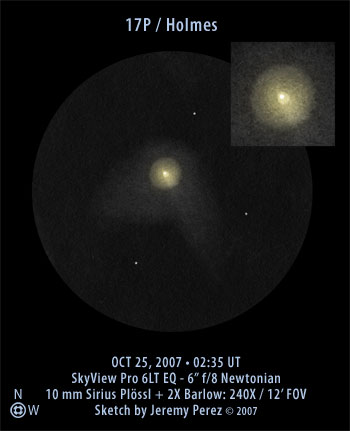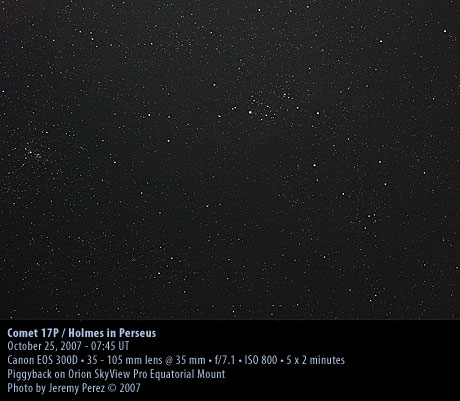
Move mouse over sketch above to view labels. Click image for larger version.
Observation Notes:
Have you ever seen a golden comet? The thought had never occurred to me–until tonight.
Earlier today, reports started arriving that observers in Asia had noted an extraordinary outburst in periodic comet 17P / Holmes. It had gone from 18th magnitude to 8th magnitude when it was first noticed. Within hours, it had became a naked-eye comet at 3rd magnitude and was still brightening. Observers were initially reporting a stellar object with a yellow or golden color. I was interested to have a look at a ‘stellar’ comet and start tracking it’s motion through Perseus. What I got was so much better.
After photographing an overhead pass of the International Space Station followed by the Space Shuttle…and a failed attempt to re-acquire C/2007 F1 (LONEOS), I got ready to check out 17P / Holmes. It was easily visible to the naked eye despite the moonlit sky. Through my 6 inch Newtonian, it was shockingly beautiful. It was not stellar at all. It looked like a wonderfully bright planetary nebula–a golden-yellow planetary nebula! I bumped up the magnification to 120X and it looked even better. It begged for more, so I gave it 240X and settled in for a nice long look. There was a very strong, almost stellar central condensation. Outside of this was another bright condensed shell about 6 arc seconds in diameter, but elongated away from the center at a PA of about 210 degrees (southwest). Further outward was another shell that was roughly circular, about 1 arc minute in diameter, with a distinct outer boundary. Outside of this was a faint, hazy outer halo about 2 arc minutes in diameter that had a broad extension at a PA of about 120 degrees (east-southeast)…perhaps this is a developing dust tail? There was also a sharper extension that matched up with the direction of the inner condensation at 210 degrees and extended about 4 arc minutes…maybe a developing ion tail?
I’m getting ready to go back outside and make some follow-up observations, sketches, and hopefully a couple photographs. I had no idea I’d get to witness something like this less than a year after the unique display put on by C/2006 P1 (McNaught). My daughter even got in on the observing and made her own sketch of the comet through our new 8 inch Dob while I worked on it through my trusty 6 inch scope. More to come!
Update October 25, 2007 – 4:00 AM
After posting this report, I went back out and shot some photos of the area. Below is a stack of 5 2-minute exposures. Move your mouse over the image to see labels and click the image for a larger version. The golden color of the comet is apparent in the image — to which I applied no color enhancement, only contrast, dark subtraction and sharpening.

Move mouse over sketch above to view labels. Click image for larger version.
| Subject | 17P / Holmes |
| Classification | Comet |
| Position* | 2:35 UT – Perseus: [RA: 03:52:53.1 / Dec: +50:08:38] 4:05 UT – Perseus: [RA: 03:52:49.8 / Dec: +50:08:56] |
| Size | Central condensation: 6 arc seconds Coma: 60 arc seconds / 1 arc minute Outer halo: 130 arc seconds / 2.2 arc minutes |
| Brightness* | ~ 2.5 vMag |
| Date/Time | October 24, 2007, 7:35 – 9:05 PM (October 25, 2007, 02:35 – 04:05 UT) |
| Observing Loc. | Flagstaff, AZ – Home |
| Instrument | SkyView Pro 6LT EQ (150 mm dia./1200 mm F/L) |
| Eyepieces/Mag. | 32 mm Sirius Plössl (37.5X) 10 mm Sirius Plössl + 2X Barlow (240X) 12 mm Meade Astrometric + 2X Barlow (~200X) |
| Conditions | Clear, calm, nearly full moon |
| Seeing | 4/10 Pickering |
| Transparency | ~ Mag 4.5 NELM |
| *Sources | Aerith.net; Starry Night Pro Plus 5 |
*Based on published data.
Excellent observation, Jeremy, one of the finest if not the finest visual observation of this comet so far. You give many important parameters and a description of the comet that can well be used by ‘professionals’ for serious analysis!
Jeremy, Thanks for the description and the drawing of Comet Holmes. People in New York City (not sure how many) got their first opportunity to view Comet Holmes.
I was walking home from work in Manhattan and from 44th St. and 2nd Ave. I was able to pick out the new triangle – delta Persei, Mirfak & Comet Holmes. At 10:30 EDT on the 25th of Oct the comet was definitely brighter than delta Persei.
A brief view with 8.5 x 42 binoculars show a magnificent object. Looked like a nuclear explosion viewed from above. The pseudo nucleus was brilliant and the coma surrounded it fairly symmetrically. The edge of the coma was distinct. I thought it looked like a bright globular but your comparison to a planetary nebula is spot on.
It’s too late to view the comet in a scope. Work! I’m hoping to be able to view it tomorrow from the park.
All the best.
Thanks guys. It really is awesome. I’m hoping to make some comparisons night by night to track changes in structure, size and brightness. That is, if I don’t lapse into a coma from lack of sleep =)
Ben, I look forward to hearing how the telescopic viewing at the park goes!
Hi Jeremy,
I’m writing from Victoria British Columbia Canada.
Congratulations on your professional info and observations, nice work! and very informative.
Last night and tonight I too have been observing P17 Holmes with my 10″ Antares Dob, complete with Denkmeier bino-viewers (which I adore). I used my 25 mm eyepieces.
What a sight!!! It is incredibly beautiful isn’t it? What a treat Holmes is since I missed our January comet…
This one looks like a cymbal to me, I playfully tell my brain that I am seeing a metal object and the similarity is striking.
Well, time to sleep… it is 3 AM…
Keep up the good work and thank you for a great site.
Isabelle, on the West coast of Canada.
Awesome sketch Jeremy! Details abound, a very subtle but well structured comet. The tails intrigue me, this one has got more than a few surprises to show us. I’ll be excited to do a few sketches of it after the much needed rain covers our fire scorched county.
Rich
Isabelle, thanks for writing. The cymbal analogy is great–I’ll be thinking of that the next time I observe it. The binoviewers have got to make the sight even more enticing. Here’s hoping the weather cooperates.
Rich, I hope things clear up for you and you are able to make some observations and sketches. I’m looking forward to seeing them. With each subsequent night, I’m wondering weather I was seeing tails or simply perceived irregularities in the outer halo. The moon is a real booger on that faint outer shell.